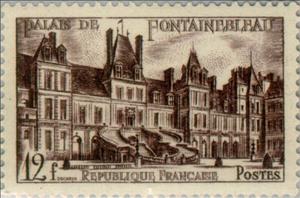Stamp: Castle Fontainebleau (The court farewell) (France 1951)
Castle Fontainebleau (The court farewell) (France 1951)
22 January (France ) within release Tourism goes into circulation Stamp Castle Fontainebleau (The court farewell) face value 12 French franc
| Stamp Castle Fontainebleau (The court farewell) in catalogues | |
|---|---|
| Yvert et Tellier: | Yt:FR 878 |
| Michel: | Mi:FR 896 |
| Stamp Number: | Sn:FR 643 |
| Stanley Gibbons: | Sg:FR 1102 |
| Unificato: | Un:FR 878 |
Stamp is horizontal format.
Stamp Castle Fontainebleau (The court farewell) it reflects the thematic directions:
Tourism is travel for pleasure or business; also the theory and practice of touring, the business of attracting, accommodating, and entertaining tourists, and the business of operating tours. Tourism may be international, or within the traveller's country. The World Tourism Organization defines tourism more generally, in terms which go "beyond the common perception of tourism as being limited to holiday activity only", as people "traveling to and staying in places outside their usual environment for not more than one consecutive year for leisure, business and other purposes". Tourism can be domestic or international, and international tourism has both incoming and outgoing implications on a country's balance of payments. Today, tourism is a major source of income for many countries, and affects the economy of both the source and host countries, in some cases being of vital importance.
A palace is a large residence, often serving as a royal residence or the home for a head of state or another high-ranking dignitary, such as a bishop or archbishop. The word is derived from the Latin name palātium, for Palatine Hill in Rome which housed the Imperial residences
A building or edifice is a structure with a roof and walls standing more or less permanently in one place, such as a house or factory. Buildings come in a variety of sizes, shapes and functions, and have been adapted throughout history for a wide number of factors, from building materials available, to weather conditions, to land prices, ground conditions, specific uses and aesthetic reasons. Buildings serve several needs of society – primarily as shelter from weather, security, living space, privacy, to store belongings, and to comfortably live and work. A building as a shelter represents a physical division of the human habitat (a place of comfort and safety) and the outside (a place that at times may be harsh and harmful).



